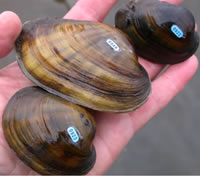
Mussel is the common name used for members of several families of bivalve molluscs, from saltwater and freshwater habitats. These groups have in common a shell whose outline is elongated and asymmetrical compared with other edible clams, which are often more or less rounded or oval.

Unio crassus, the thick shelled river mussel, is a species of freshwater mussel, an aquatic bivalve mollusk in the family Unionidae, the river mussels.

The freshwater pearl mussel is an endangered species of freshwater mussel, an aquatic bivalve mollusc in the family Margaritiferidae.

Unionida is a monophyletic order of freshwater mussels, aquatic bivalve molluscs. The order includes most of the larger freshwater mussels, including the freshwater pearl mussels. The most common families are the Unionidae and the Margaritiferidae. All have in common a larval stage that is temporarily parasitic on fish, nacreous shells, high in organic matter, that may crack upon drying out, and siphons too short to permit the animal to live deeply buried in sediment.

The elktoe is a species of freshwater mussel, an aquatic bivalve mollusk in the family Unionidae, the river mussels. This species is found in southeastern Canada and the eastern United States. Like many mussels, it is threatened by water pollution from agriculture, industry, and other development, such as acid mine drainage and sedimentation. It may be extinct in Oklahoma.

Cumberlandia monodonta is a freshwater mussel endemic to the United States. Currently, C. monodonta is listed as an endangered species by the U.S. Fish and Wildlife Service and the International Union for Conservation of Nature.

Fusconaia escambia, the narrow pigtoe, is a freshwater bivalve mussel found in Alabama and northwestern Florida. The narrow pigtoe was first discovered in the Escambia River in Alabama and Florida.

Lampsilis abrupta, the pink mucket or pink mucket pearly mussel, is a species of freshwater mussel, an aquatic bivalve mollusk in the family Unionidae, the river mussels. This species is endemic to the United States.

Hamiota altilis, the finelined pocketbook, is a species of freshwater mussel, an aquatic bivalve mollusk in the family Unionidae, the river mussels.

Lampsilis higginsii is a rare species of freshwater mussel known as Higgins' eye pearly mussel or simply Higgins' eye. It is endemic to the United States, where it occurs in the upper Mississippi River and the drainages of some of its tributaries. It is threatened by the introduced zebra mussel. Lampsilis higginsii is a federally listed endangered species.

Hamiota perovalis, the orangenacre mucket or orange-nacre mucket, is a species of freshwater mussel, an aquatic bivalve mollusk in the family Unionidae, the river mussels.

The Carolina heelsplitter is a species of freshwater mussel, an aquatic bivalve mollusk in the family Unionidae.

Potamilus leptodon, the scaleshell mussel or scale shell, is a species of freshwater mussel in the family Unionidae, the river mussels. This aquatic bivalve mollusk has disappeared from much of its historical range. It is endemic to the United States, where it is now present in four or fewer states; it is only found with any regularity in Missouri. It is a federally listed endangered species of the United States.

Obovaria retusa is a rare species of freshwater mussel in the family Unionidae, the river mussels. Its common names include golf stick pearly mussel and ring pink.

Paetulunio fabalis, the rayed bean, is a species of freshwater mussel, an aquatic bivalve mollusk in the family Unionidae, the river mussels. It is the only species in the genus Paetulunio, and was formerly classified in Villosa until a 2018 study.

The shinyrayed pocketbook is an endangered species of freshwater mussel in the family Unionidae, the river mussels. This species is endemic to the United States in the states of Georgia, Florida, and Alabama.

Strophitus undulatus is a species of mussel in the Unionidae, the river mussels. It is native to eastern Canada and the eastern United States. Its common names include creeper, squawfoot, sloughfoot, and strange floater.

Megalonaias nervosa, the Washboard is a freshwater mussel species in the family Unionidae.
Sinanodonta beringiana, the Yukon floater, is a freshwater mussel, an aquatic bivalve mollusk in the family Unionidae, the river mussels.

Hamiota australis, the southern sandshell, is a species of freshwater mussel, an aquatic bivalve mollusc in the family Unionidae, the river mussels.




















